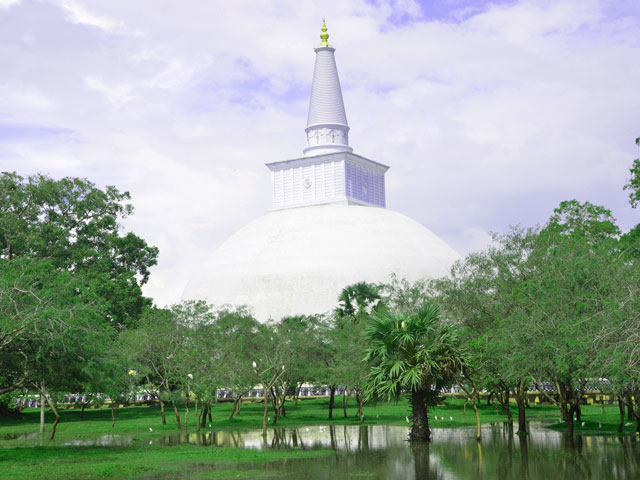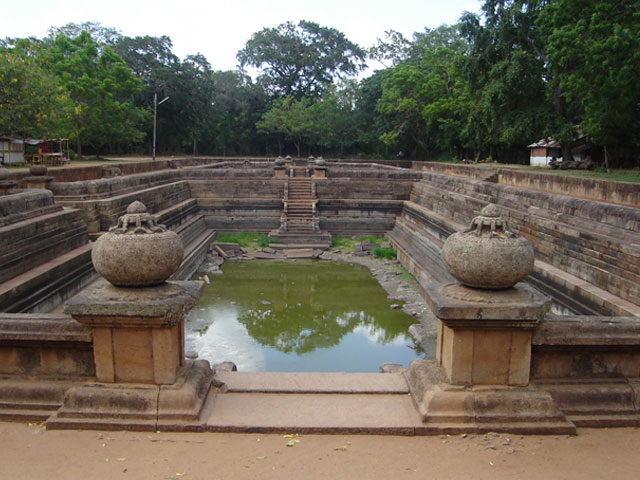Anuradhapura
Sri Lanka's First Kingdom
Anuradhapura became the capital of Sri Lanka in the 4th century BC. Sri Lankan history from the 4th century BC up to 10th century A.D is generally referred as “Anuradhapura” period. King “Pandukabhaya” the third king of Vijayan dynasty became the king after great struggle against his uncles. He is the one who formally planned the city, with gates, quarters for traders etc. Anuradhapura kingdom lasted one thousand and four hundred years until it was invaded by South Indian Chola forces in 1017. It was a very wealthy city which created a unique culture and a great civilization. Today Anuradhapura is one of the world’s major archaeological site it is covered area about 40 km².
Introduction of Buddhism took place in reign of king “Devanampiyathissa” in 250~210 B.C. During this time Emperor Ashoka in India sent many Buddhist missionaries to Asian ountries. King “Devanampiyathissa” was a close friend of Emperor Ashoka ,he sent his son “Mahindha” thera as the head of a mission to introduce Buddhism to Sri Lanka. By the introduction of the Buddhism, the city gained more prominence and the great building era began. During this time vast monastery complexes and some of the tallest buildings in the ancient world were built for example Jetavanaramaya, Maha Vihara and Abhayagiri. The Jetavanaramaya dagoba is treated as the tallest brick structure in the world. As Anuradhapura city was in dry zone rulers constructed large lakes to irrigate paddy lands and also to supply water to the city and also it had the most complex irrigation systems of the ancient world.
Highlights of Anuradhapura
Sri Maha Bodhia - The Sacred Tree of Buddhists
Sri Maha Bodhia is the right branch of the secred Bodhi tree where Buddha attained enlightenment. This was brought to Sri Lanka by “Sangamitta Their” in 3rd century B.C. The Bodhi branch was received with respect by the King Devanampiyathissa and was planted in the terrace prepaired for it in Mahameuna garden Anuradhapura. This is treated as the oldest living tree in the world in documented history and it is a place respected by Buddhist’s from all around the world.
Ruwanweli Stupa the magnificent Stupa in Anuradhapura
Ruvanveli Dagoba was built by King Dutugemunu , who is treated as one of the most outstanding ancient Kings of Sri Lanka and this treated as one of the most greatest Stupas in the world.This magnificent huge Dagaba which is 103 meters in height and 287 meters in circumference was built in 2nd century B.C
King Dutugamunu didn’t live to see the completion of this chethiya. When the king fell ill he sent his brother to complete the work of the stupa. Around this stupa you will also see statues made out of stones of King Dutugamunu, Queen Vihara Mahadevi (Mother of king Dutugamunu) and King Bhathika Tissa of 2nd Century.
Lovamahapaya - The Great Copper Roofed Mansion
The king Devamnampiyatissa, the first Buddhist king of the country build a chapter house in this location on the instructions Mahinda Thero who brought Buddhism to the country. A century later king Dutugamunu (161-131 BC) built a massive structure of which the remains you see today.
According to Mahavamsa, the great chronicle of the Sinhalese, this was a massive nine storied building with a height of 150 ft (47 meters) and each side with a 150 feet (46 meters) length. The building was supported by 40 rows of stone pillars with 40 pillars which totaled 1600 pillars. In each level there were 1000 rooms and 100 windows. The building was adorned with corals and precious stones. Its roof was covered with copper-bronze plates. Although this description may be a little exaggerated, this would have been a very impressive building at that time looking at what remains today.
Abhayagiri Stupa in Anauradhapura
It was King Valagamba (Vattagamani Abhaya) in 103 B.C. founded this large monastery Abhayagiriya and gave it to Mahathissa thera who had protected the king when in adversity. Abhayagiriya is treated as the second highest dagoba in Sri Lanka.
Proof has been found that a Jain temple has existed on this land in the 5th century BC during the rule of King Pandukabaya (437-367 BC).
The magnificent Twin Ponds of Anuradhapura
Kuttam Pokuna or the twin ponds are another hydrologic engineering marvels of the ancient Sri Lanka. These two ponds belong to the Abayagiri aramic complex and probably been used by the monks for bathing. The origins of these ponds are not known but it is thought to have been built during the reign of King Aggabodhi I (575-608).
Water to these ponds have been supplied through underground pipelines and the water is sent through several filtering chambers before it falls on the northern pond through a mouth of a dragon. The water from both ponds is drained from a small outlet in the smaller northern pond
Elephant Pond (Eth Pokuna)
This gigantic man-made pond is situated close to Lankaramaya. This is 159 meters in length 52.7 meters across and 9.5 meters in-depth with the holding capacity of 75,000 cubic meters of water. The water to this pond has been supplied from the Periyamkulama Tank through a network of underground canals, and you still can see part of the water lines made out of stone blocks.
These underground canals still work after so many hundreds years and in 1982 after a very heavy rainy season you could see water pouring though these inlets from the Periyamkulama tank. This tank probably has been used by the monks in the Abayagiri monastery who amounted over five thousand priests.
Aukana Buddha Statue
Our ancient sculptures in stone in the form of Buddha statues, sluices, guard stones , pillars and other such artifacts are over 2000 years old. Among the largest such standing Buddha statues is this famed Aukana Buddha statue lying amidst Raja Rata – the cradle of our ancient civilization. It is carved out of a rock boulder and lies close to the serene Kala Weva tank built by King Dhatusena of the 5th century AD.
The Aukana Buddha colossus in stone is also easily accessible through the Mahaweli System H, at Galnewa. This Aukana Buddha statue is 46-feet high, resting on a fine lotus stone pedestal. The symbolic gesture carved on the statue, called Mudra is in the form of Ashiva Mudra which signifies giving or blessing.
Thuparamaya The very first Stupa built in Ceylon
On this stupa you can see a unique architectural feature called vatadagê, a stupa-house. This building completely housed the stupa. At present four concentric circles of stone pillars are found around the stupa. They diminish in height from inner most circle and at one time carried the weight of a dome-shaped roof over the stupa. There has been 176 pillars which supported this stupa house and in 1896, 31 complete pillars with capitals has been standing. This vatadagê has been built in the 1st century AC.
The Aukana Buddha colossus in stone is also easily accessible through the Mahaweli System H, at Galnewa. This Aukana Buddha statue is 46-feet high, resting on a fine lotus stone pedestal. The symbolic gesture carved on the statue, called Mudra is in the form of Ashiva Mudra which signifies giving or blessing.
Samadhi Buddha Statue
Samadhi Statue is considered one of the best sculptures in the Anuradhapura era. It is thought to be done during the 3rd or the 4th century. It is made out of dolomite marble and stands 7 feet 3 inches (2.21 metres) in height. This statue was found in the present location in 1886 fallen to the ground with damages to the nose. It was then erected and the nose was reconstructed. In 1914, it was found damaged by treasure hunters and re constructed again.
The statue’s eyes are hollow indicating they were impressed with crystal or precious stones. It is unclear whether this and the 2nd statue were brought from another vihara or they were originally kept here.
Magnificent stone carving of Isurumuniya Lovers
The Meghagiri Vihara is now commonly known as Isurumuniya Vihara or Isurumuniya. But the real Isurumuni Vihara is located few hundred metres away is now called Vessagiri Vihara. Isurumuniya is most famous for the stone carving of a couple located there. This carved stone was found in the royal pleasure garden and brought here. There are many interpretations for this carving.
The most popular is that this carving shows the prince Saliya (the son of the great king Dutugamunu) and his mistress Asokamala. Asokamala was of a lover cast called “Chandala” and the prince Saliya gave up the right to be the king by marrying this girl of a lower cast. Another belief is that this couple represent the god Siva and goddess Parvathi of Hindu belief.
Mihintale sri lanka
In the 3rd century BC, area of Mihinthalawa was a thick jungle area inhibited by wild animals and was a hunting ground reserved for the royals. All this changed in 250 BC when the son of the Indian Emperor Asoka, Mahinda Maha Thero arrived at the Missaka Pauwa to meet king Devamnampiyatissa for the first time and asked the famous questions to decide whether he is intelligent enough to understand the philosophy of the Buddha. Initially Mahinda Maha Thero’s residence, but later Mihinthale became a main center for Theravada Buddhism and is considered the cradle of Buddhism in Sri Lanka
Jetavanarama Stupa in Sri Lanka
During the reign of king Gothabhaya (253-266 AC) a disagreement took place between the monks of Mahavihara Monastery and the Abhayagiri Monastery regarding a certain doctrine. The king Gothabhaya took the side of the Mahavihara and took severe measures against the monks of the Abhayagiri Monastery. During this time the monks of this monastery had to seek sanctuary in India.
Mirisawetiya stupa Sri lanka
Mirisawetiya Dagaba has been built by King Dutugamunu (161-137 BC) and this belongs to Mahavihara Complex. King Dutugamunu is the great king who defeated the Tamil invaders who ruled the country for 30 years and brought the country under one ruler.
When the great king Dutugamunu was going to the water festival after his consecration he left his sceptre (kunta) which had a scared relic of Buddha inside, on this location. When he returned the kunta was stuck and nobody could remove it. So the king seeing this miracle constructed a Dagaba here.




















































